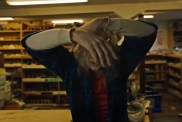Having set international box office records, James Cameron’s sci-fi epic Avatar brought a lot of people who rarely go to the movies back into theaters over the last four months, in large part due to the use of innovative and patented 3D technology that helped pull people into the world of Pandora along with Sam Worthington’s Jake Sully.
When it comes to the movie’s release on Blu-ray and DVD, one would think it would be just as groundbreaking, so many people were surprised to learn a no-frills movie-only version would be released on Earth Day, April 22, just four months after the movie’s theatrical release. There’s definitely a method to the madness, including Cameron wanting to release the highest quality high-definition version of the movie as possible, using the entire capacity of a Blu-ray disc for that, rather than including lots of bells and whistles. Instead, they’ll be saving that for a four-disc version being prepared for November which will include deleted scenes, a two-hour documentary on the making of the movie and more.
Last week, ComingSoon.net sat down with the film’s producer, Jon Landau from Lightstorm Entertainment, to pose some of the questions that many people have about the movie, the DVD/Blu-ray release and the technical aspects of each, which he was more than happy to answer.
ComingSoon.net: I talked to Sam last year and he mentioned how James really wanted to bring people back into theaters and give them the ultimate theatrical experience. Now you have the Blu-ray coming out with the best possible picture. Could you talk about why you guys decided to release this so soon rather than waiting?
John Landau: Two things when you say so soon it’s funny because it’s wrong.
CS: It’s been four months, but the movie’s still playing well in theaters and is still in the Top 12.
Landau: Yeah, but there’s such a demand worldwide for people who want to return to Pandora that we felt that to do it. With the added content that we want to do in today’s day and age – the internet has made behind the scenes footage available prior to a DVD release, so you can’t just put that on there because people have seen that already. You have to create original content to support the added value material. So we needed the time in order to create the appropriate added value content including scenes that weren’t in the movie that Weta Digital is now taking four to five months to finish scenes to be in the movie. We just couldn’t wait for a DVD release until November and we couldn’t get that content ready before then. So we chose to say, “Let’s get rid of all the frills. Let’s get rid of trailers. Let’s get rid of commercials. Let’s get rid of director’s commentary and utilize every available bit of this space for the presentation of the film itself.” We went with very simplistic menus again because things that I didn’t know about before we sort of had this mandate of say, “Can we elaborate on the menu a little bit?” They said, “We could, but you have to do nine different versions and you gotta do it in French, you gotta do it in Spanish and you gotta do all this different branching and it’s gonna take up this space, so you’re gonna lose something off of the picture quality,” and we just didn’t want to do that.
CS: So are you talking in the future about having a director’s cut?
Landau: Well, this is the director’s cut.
CS: But you mentioned additional scenes.
Landau: Right, but again, I think another thing that was very important for Jim is that the movie go out the first time as the director’s cut. This is his version of the movie. Anything we do down the road, it’s going to be fan-based. Jim put his best foot forward. There’s a lot of stuff that’s great content. There was really no scene in the movie that did not work as a part, but to create the best version of the whole as a way to introduce the world to “Avatar,” it’s this version of the movie. Now that people are a little bit more familiar with the world, do you have another couple of minutes to tell a little bit more of the back story, behind the scenes in the school that Sigourney taught at? Do you have time to see a little more action of Jake maybe in his training? You know, those are the type of things that we might have more room to do now and would make available.
CS: I wanted to ask about the four-month gap from the theatrical release. That’s normally an adequate period of time for a movie to go to DVD but your movie is anomaly, having been #1 for seven weeks and still in theaters. Since people can still see it in theaters, why release it on DVD now?
Landau: Look, I don’t think the two experiences are mutually exclusive. I think that there are gonna be people who say, “I want to go see ‘Avatar’ on an IMAX screen and get the DVD.” I mean, I think its two different experiences and fulfills two different requirements. I think it’s interesting that people make a big deal when people go back and see a movie again for a second time. However, they don’t make a big deal when we listen to a piece of music over and over and over. It’s really to me, that same type of thing, and what owning the disc does, it’s like owning an album. You don’t have to wait to go see the concert, but when the concert’s available for your favorite band, you still go see it. But in the meantime you have it. I think that’s the way with these type of movies it works. With “Star Wars” it works that way. With some of the comedies that have been very successful in the home entertainment. People want that because it’s their way of listening to music.
CS: Does the home format change the emphasis of the movie at all?
Landau: No, no, and nor does 3D. I think there’s a lot of misconception about that. We made this movie in 2D. And by that I mean we shot it in 3D, but we edited it in 2D. We wrote in 2D, I mean, we didn’t change the writing. The character journeys and their stories are 2D based. We mix and score in 2D. The first time we saw the movie as a whole in 3D was two weeks before its release. No, we’d seen shots and so we knew what the 3D was and that there were no technical problems, but the creative aesthetics of putting together a movie were the same ones that we would do in 2D and I think that applies to whether you’re going to the theaters or whether you’re going into the home.
CS: I’ve talked to a bunch of people about making 3D movies and the biggest problem seems to come down to how the movies are edited where movies with lots of edits makes it harder to adjust to the 3D than ones with longer shots.
Landau: Can I get technical and geeky for a second? (Laughs) Okay, so the problem being in the past that the camera, the capture system, did not allow the cameras to simulate human vision. I mean, my eyes continue to converge on my finger, they tow in and they tow out. If you put that into your camera, you’re not asking the audience to do it when they watch a movie. So, therefore, if you converge, which is where you intersect, at your subject of focus you can cut as fast as you want because that subject of focus will always be at the screen plane because if you take off your glasses and watch 3D, where you see one image is the screen plane. Where it’s crossed, it’s in front of the screen plane and where it’s separated, it’s behind the screen plane. So where you have a problem is if you have a shot that’s behind the screen plane that you’re looking at, the focus is, and then one that’s in front and then one that’s back and one that’s behind. But, if you’re always converged at your subject of focus, the audience is looking there and it’s cutting, cutting, cutting, cutting and you don’t have a problem.

CS: You are adjusting convergence while you’re filming rather than having it remain static per shot…
Landau: We call it dynamic convergence. We have dynamic convergence and dynamic inner ocular. Inner ocular is the distance between the two lenses that creates the sense of stereo. The greater the inner ocular, the more stereo, a zero inner ocular is 2D. So that’s sort of the easiest way to… (motioning with his hands to show the differences) well, that’s 2D, that’s a little 3D. That’s a lot 3D, that’s probably too much 3D because you might have one camera on that shoulder and one camera on that shoulder. So you don’t want that.
CS: What percentage of the gross for “Avatar” was from 3D vs. 2D?
Landau: You know, I don’t know those statistics and again, I think it changes territory by territory interestingly enough because in some territories they don’t have any 3D, but that didn’t stop the movie from being successful. I think if I had to guess here in the States I think surprisingly it was probably 60, 40 3D. I think we would’ve thought that it would’ve been less, but I think it’s interesting. That’s why I think that you’re gonna see hopefully with “Avatar” the Blu-ray sales out-percentage the normal, home entertainment release because I think people have associated with “Avatar” in seeing it in a certain type of quality presentation. So, that despite the fact that this movie was the most pirated movie of all time, it’s also the number one box office movie of all time ’cause people said, “Okay, I could get it here, but I still want to see it that way.” So if somebody might download it to their iPhone, I think they’re still gonna say, “You know what? I still wanna see it if I have a Blu-ray player, that’s gonna be on Blu-ray.”
CS: With all the talk of 3D, will we see a 3D version on Blu-ray as well?
Landau: Well, I think ultimately there definitely will be. I think right now it’s too premature. We would a little bit be the egg coming before the chicken. (Laughs) You know, we’ve worked with a lot of the manufacturers to ensure that there’s gonna be a high quality of 3D out there in the marketplace, but the last thing you want to do is go out on some of these screens you’ve seen in the past where the quality just isn’t there.
CS: By November and December, there should be 3D TVs from several companies in the marketplace, selling for the Christmas season.
Landau: I think there will be and we just have to evaluate how the consumer’s embracing that over the next months and what format really takes hold. We spent a lot of time on this initial release going back in and color timing. Jim spent a week with the color time as he did for the movie where he went and didn’t have one monitor in front of him, he had an array of monitors that represented what is in the home marketplace today to make sure that the colors in the world is representative of what the movie was. When we did our encoding down to the disc, we didn’t spend the normal two weeks, we spent five weeks and had people from Lightstorm monitoring what was gonna be there. We want to be able to do the same thing (with 3D) and have the time to do it when we see which one takes the best hold out there in the marketplace. I would love for it to be December, it might be next June. I mean, it’s gonna be when there is enough of a penetration in the marketplace that warrants the time and effort to do it and to make sure we do it right.
CS: We’re talking a lot about visuals, what about the audio?
Landau: The audio, we did a special mix for the home entertainment with our same mixers, Chris Boyes and the folks from Skywalker came in and Jim supervised it and we did it for home theater systems and made it work. There was some adjusting that needed to happen, but look, I think that a movie is no one thing. A movie is not just visuals. A movie is not just this. It’s the whole. In fact, sound is a very important aspect of that, so they spent a lot of time doing that.
CS: A lot of movies are gonna benefit from the technology and work that was done on “Avatar” even if they have nothing to do with “Avatar.”
Landau: Well, I think the industry and the consumer are going to benefit because to me, I think what “Avatar” has done more than anything else, it’s opened a small crack in the door that is now gonna allow filmmakers to make movies that otherwise could not be made. You know, movies that now have CGI, computer generated characters at the center of it, but characters that can be engaging or emotive. You know, there have been great stories locked in the heads of filmmakers, or on the great pages of literature that just have no way to be realized. Maybe now is, again, a small crack in that door.
CS: Paul Anderson is actually using the same camera system for his “Resident Evil” movie, but how about these movies that are shooting in 2D and then converting and people aren’t happy with the results. I’m not going to say names because we all know what we’re talking about.
Landau: Well look, here’s what I would say about conversion. Conversion is an artistic process and not a technical process and you have to involve the creative team and the filmmakers in that process. To do anything artistically takes time. To try and do something in seven weeks or 10 weeks while the filmmaker is still finishing the movie and shots are still being delivered by the visual effects company can not be anything but a technical process and can be nothing at times, more than a poor technical process. I say to filmmakers out there who are considering it, I say, “You know what? Fine, if you want to do that why don’t you just shoot your movie in black and white and convert it to color at the end?” It’s the same thing. You would not allow someone else to go colorize your movie after you shot it on black and white because how you shoot it and how you light it and the color, it’s an artistic thing that you’re a part of. Shoot it in 3D, you have the technology capability to do it now. There’s this misconception that 3D takes longer in post. I’ll argue it’s shorter in post, why? Because, when you shoot on a set it’s all digital now with 3D. You see your dailies live. So you don’t have to wait for it to come back. You know what you’re really getting or you don’t know what you’re getting and you can redo it if you want to do it. Even on the visual effects side, when you’re doing it, it’s really about render time. So it’s just about how many computer processors you want to put on to add time. We had companies that came in, ILM came onto “Avatar” to help us out with additional shots and they had several hundred shots that they completed in less than 18 weeks which is a normal post production process. So if they could do it coming late to the game and not have the advantage of production and all of that, you can do that for any film.

CS: Yeah, but that’s ILM.
Landau: No, but ILM we had others. Prime Focus came on. We had Hydrolics come on. We ended up with nine different vendors who did work. It’s again, in today’s world where, you know, computer technology is what it is, it’s amazing. Interestingly enough, and the costs are not that exorbitant because something that cost us on “Titanic” literally for one terabyte of storage, high end storage capabilities, digital domain had to go to the board to get special permission for $750,000 for one terabyte of storage. On “Avatar,” Weta Digital had a petabyte of storage just as a normal I mean, you could not have done that at $750,000 a pop. (Laughs)
CS: How much more expensive would it be for someone to use this camera technology developed for “Avatar,” and how much more would it add onto movies that might want to use the system?
Landau: Let’s separate the systems. So you have the 3D live action camera system and then you have the virtual system. So as you talk about “Resident Evil,” they’re just the 3D. I would say two to three percent on their overall budget. People are like, always shocked when I say that until I walk them through it and say, “Okay, what is normally the largest cost of a movie above the line, you know, it’s a big chunk of it the stars, the director, the script. You don’t pay more for that in 3D. All right, what’s the next big cost? Construction building sets. You don’t pay more for that. You don’t pay more for set dressing. 3D effects three areas of a budget your camera department, your camera equipment, even if you say it’s double, but that’s one small part of the camera budget, and maybe you have one additional staff person on. Your director of photography doesn’t get more. They’re the most expensive person in that department. Then you have finishing costs. You have, when you do your color timing you’re doing two eyes instead of one, but again, not that extensive an area of a budget. Then, you have visual effects. Visual effects, it’s a little bit like a bell curve. If you’re doing a pure live action movie, you’re at the bottom of the bell curve, there’s no added visual effects costs. As you get into a hybrid of CGI and live action, you get to the top of the bell curve and then as you go back to all CGI, you come back to the bottom because that’s then easy. So, even in the visual effects area, it only affects a small area of visual effects costs because if you do animation, you do it once. If you do lighting, you do it once. Those are the two most labor intensive areas. If you do rotoscoping which is cleaning up all the matte lines, you have to do that twice and you have to do rendering twice. But, that’s again, a small fraction of that budget. So maybe your visual effects budget goes up 10 to 15 percent, but if you add those all up of the overall budget, it’s only two to three percent of the overall budget.
CS: That’s assuming that the visual effects budget for your movie is greater than the above the line.
Landau: It is, but it’s still a small percentage because you’re only going up in visual effects 10 percent, so if that represents 50 percent of your budget and you go up one percent in your budget, you really have a job at four or five percent to do your whole movie.
CS: What else can we expect from the special features in November?
Landau: We have some really great, I think, innovative ideas on really exposing the process. It’s gonna be a four-disc collection when we come out with it, dedicating one disc to we’ll call it a two-hour plus documentary about the journey of making the movie. We want to get into other behind the scenes branching availability, being able to see the movie at the different stages where you can really watch what we call the template version, which is what we turned over to Weta Digital, be able to watch animation passes back, picture in picture so you can see how the performances really track to what the actors did and everything like that. I don’t know if we’ll call it Special Edition or Uber Edition or Pandora Edition.
CS: Pandora’s Box.
Landau: There you go.
CS: Are you going to have any sort of theatrical release for the documentary part of it?
Landau: I think it’ll be more for the Blu-ray.
CS: When will we see “Titanic” on Blu-ray?
Landau: Our next plan for “Titanic” is to take the time and do a conversion right to 3D.
CS: So we’re talking next year, the year after? Wait a minute, the anniversary’s 2012.
Landau: There you go, which is also coincidentally the 15th anniversary of the film. So you have the ship sinking 100th anniversary. It might even be Paramount’s 75th anniversary. I don’t know. (Editor’s Note: 2012 will actually be Paramount’s 100th anniversary) There might be a whole bunch of stuff.
CS: People said they would never see that film because they knew the ending.
Landau: (Laughs) Exactly, exactly. Yeah, but it’s interesting, I think people can never prejudge a film and what the journey is that you go on for any movie whether it be “Titanic” or “Avatar” or “Train Your Dragon” or any of these movies. You have to go see ’em and it’s about the characters. It was really interesting when we did our first preview on “Titanic” in Minneapolis. We wanted to go to sort of the heartland of America. We knew that the movie was too long and our goal was to take the “t, o, o” out of that statement because we knew the movie would always be long. The best news that we got coming out of that screening is that where people felt it was too long was in the sinking. It wasn’t like, “Get me to the sinking faster and lose that character stuff.” It was, “Give me that character stuff, but I don’t need the stuff that’s not character based.” That was really reinforcing to us about it. There was another thing that I’ll just throw out which is that Jim said he learned something from “The Abyss.” If you look at both “Titanic” and “Avatar,” he lived by what he learned. He said, “The emotional climax has to come after the visceral climax,” which it didn’t in “The Abyss.”
CS: Could you talk about the tie-in with Earth Day and then the plans to have a million trees planted?
Landau: When Fox came to us saying, “We love that.” This idea was not doing the release on a normal Tuesday, but that Earth Day was the target day. I mean, we didn’t pick this next week for any other reason but for Earth Day and being able to make that connection. You know, “Avatar” starts with and ends with the same image, eyes opening. By tying this to Earth Day, we are asking the public at large to open their eyes and just take a moment to appreciate the world around us. They don’t have to do anything else at that point, but Fox has then made a commitment to plant one million trees before the end of the year. I asked them, “What does that mean, plant?” They said, “No, we’re gonna plant and guarantee them to maturity.” So they’re just not gonna leave ’em and let ’em blow over in a storm or whatever because look, you plant it, a car drives over it, it’s gone. So, it defeated that purpose. The only specifics that I know is in Brazil they will plant over 200,000 trees in Brazil alone. Then, the rest will be spread around the world. There’s other programs that are going on. I know Jim is participating in an event in Los Angeles for inner city youth children on Earth Day sort of educating them about some of the environmental issues. We’re a part of an event in Washington, D.C. on the 25th where Jim will actually be speaking at the Mall and talking about things. We are doing an event here in New York on the 24th with the United Nations about indigenous people around the world. So it’s sort of just bringing into the public consciousness that this is an issue out there for them to just think about really.

CS: Was this something that was always planned while you were making the movie? Or did it just come about?
Landau: Earth Day was not planned. (Laughs) No, look, I believe that movies that are successful are movies that have themes that are bigger than their genre. When I was out there pitching the movie to people who knew nothing and just bring them into a cold room and try to tell them about the movie. I would talk about Jake and the journey that he went on and that he started out with a voiceover at the beginning of the movie that he always wanted to fight for something, but he never found anything truly worth fighting for. Then, when he came to Pandora, he learned. He learned to appreciate people of a different race, a different color, and it gave him the appreciation for the world around him which is something he never had before and that he learned that the corporation by mining the planet was destroying the planet and that that gave him for saying that was always worth fighting for. He then led the revolution. So that, I mean, that’s how I pitched it five years ago starting in April of ’05. So it was always part of the consciousness. Now, I will tell you there were skeptics on the outside at the studio who thought that we needed to downplay that, that the movie couldn’t be “Ferngully.” No, seriously, and these were issues. They didn’t think it could be blue people. They didn’t think they could have tails. It was like, this is why and this is why it’s important.
CS: So much time will be spent between now and November putting together this other Blu-ray collection. How does that affect you and Jim working on other projects? Obviously it’s been a long time between “Titanic” and “Avatar”; people all want to see you guys work on something else.
Landau: Well, I think the good news is that we have systems and methodologies in place that will not consume a lot of Jim’s time. I think Jim’s time will be surgical coming in. You know, we have a very good behind-the-scenes crews working on this two hour documentary that we want to put together. Jim’s not doing it himself. We have Weta Digital working on these shots, but we’ve kept on our animation supervisor whose functioning now as our visual effects supervisor. So, he’ll take all of us to a certain point and then Jim will be able to come in, but hopefully he’ll be able to go off and get started on some other stuff.
CS: With all the projects he has with development over the years, have you guys looked at other directors for some of them?
Landau: Well, we’ve looked into directors on a movie called “Fantastic Voyage” that we’re talking about. We’ve been in conversations with Paul Greengrass to do that. So, we are certainly open to that, but there are already a small number of movies that Jim wants to do himself. But, I think that he doesn’t want to say that he can do things that he’s not gonna have time for and we know that whatever movie he does is not gonna be done in six months. (Laughs)
CS: What kind of pressure do you have to do another “Avatar” movie, whether it’s another Pandora movie, or another movie with Jake or whatever you’re gonna do? Obviously, you had so many ideas in this movie, now you have to try and take another movie and try to make it as important.
Landau: Well, look, I think that one of the things that we have been successful at is that the most pressure we feel is our own pressure. I think that’s true as we go through a movie and make a movie whether it be “Titanic” or “Avatar.” Our pressure about an “Avatar” sequel is self-imposed. We’ve always said that if the public wanted a sequel that we would do a sequel. But, had that hadn’t been said, in my opinion, Jim has done two sequels in his career and both times he has at least equaled if not surpassed the original movie. We are only gonna do it when we have a piece of material, the script that we believe will be at least as entertaining and as unique as the first movie was.
CS: The possibilities are so endless now due to the fact that you’ve got all sorts of new technology, that opens up some possibilities.
Landau: It is endless. Not only that, the hard part is out of the way. We figured out how to do it. Our goal in the next one is to do it more cost-effectively and more time-efficiently and we have kept on a team of our technical staff who is working right now on Gen 2 of what we did, but with all the experience that we’ve had we’ve kept them on and they’re working for us right now.
Avatar is out on Thursday, April 22, Earth Day, on Blu-ray and DVD, and you can order it through Amazon by clicking on the appropriate link.









